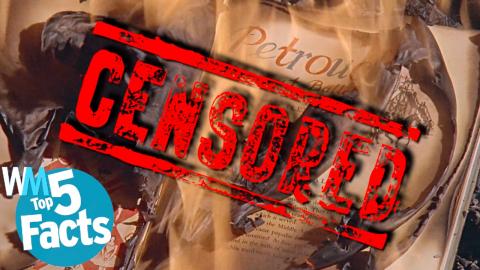Top 5 Facts About Banned Literature

Ahhhh civilization… it's a balancing act between acquiring knowledge and wiping it from our collective history. Welcome to WatchMojo's Top 5 Facts and in today's installment we're counting down the Top 5 Facts About Banned Literature.
Every year, people across America fight back against censorship by partaking in “Banned Books Week,” which runs during the last week of each September. But you don't need to wait until then to familiarize yourself with humanity's love/hate relationship with the written word. Come along as we skim through the many chapters and plot points that make up the story of banned literature.
Special thanks to our user David Weinhold for submitting the idea on our interactive suggestion tool: WatchMojo.comsuggest
#5: A History of Censorship - By Fire
In the modern western world, when a book is banned, it most often means that the publication in question simply can’t be taught in school or made available at libraries. But throughout human history, prohibited texts have been subjected to much stricter censorship. Across various cultures, book burning has been the go-to method of protecting the public from so-called “dangerous knowledge.” In 213 BC, the first Emperor of the Qin Dynasty allegedly had history books, poetry and philosophy burned in an effort to consolidate power. It’s also suspected that the destruction by fire of the Library of Alexandria may have been intentional. Fast-forward through countless historic book burnings and we get to Nazi Germany, where ten of thousands of books were burned in the name of preserving the German identity, often by students.
#4: A Book Is Challenged, Then Banned
So what’s the process for banning a book nowadays if not “trial by fire”? Before a book can be officially banned in any institution, it needs to be challenged and a case made for it to be censored. Who cares enough to go through such trouble rather than just, you know... not reading the book? According to the American Library Association? Parents. As of 2015, 40% of all challenges come from parents. On average, a few hundred challenges are recorded each year by the ALA. But how does a book go from challenged to banned? A governing body or committee of the school or library in question will meet and review the challenge. Typically, unless material is found to be glaringly offensive to the general public, most institutions will not ban a book unless it receives numerous challenges.
#3: Many of the Most Famous Books Have Been Banned in Various Places
The more famous, critically acclaimed or academically analyzed a book or series is… the more likely it is to have been challenged. Essentially, the more culturally relevant a book is, the more some folks want to see it kept out of impressionable hands. The likes of Catch 22, The Perks of Being A Wallflower, The Fault in Our Stars, The Adventures of Tom Sawyer, The Grapes of Wrath, Slaughterhouse-Five, Naked Lunch, Fahrenheit 451, Anne Frank: The Diary of a Young Girl, and the Harry Potter series have all been banned by various school boards, schools or libraries in America over the years. Why? The justifications are varied: immoral, against family values, racist, homosexuality, violent content, sexual content, age inappropriate, political views, the consumption of substances and many, many more.
#2: Taboo Books Have Gotten People in Legal Trouble
While many fans of free speech and creative expression openly scoff at the challenging and banning of books, historically, ignoring such bans has landed people in serious hot water. When Allen Ginsberg’s controversial poem “Howl” was published in 1956, various people were arrested and accused of obscenity, including bookseller Shigeyoshi Murao, and Lawrence Ferlinghetti, the book’s publisher. In the end, both were declared innocent. What’s more, teachers who ignore school bans on certain books have been fired. Throughout the 1960s, multiple American teachers were dismissed for teaching Catcher in the Rye, 1984 and One Flew Over the Cuckoo’s Nest. And while some teachers got their jobs back, others weren’t so lucky.
#1: The Justifications Aren’t Always Understandable
Sure, there are arguments for banning books. Admittedly, you wouldn’t want someone teaching graphic, sexually explicit material to elementary school kids. The issue with banning books, however, is that it sets a dangerous precedent. Where do you draw the line? Scott Dimarco, a Mansfield University librarian, wanted to highlight just that issue when he intentionally banned an undeserving book in order to draw attention to the problem inherent with censorship. Plenty of books have been banned or challenged for ridiculous reasons before, but sadly, not to prove a point. Harriet the Spy for encouraging sneaky behavior, Little Red Riding Hood for showing a child in possession of wine, and Brown Bear, Brown Bear, What Do You See? because the author had the same name as a Marxist theorist. So there’s that...
